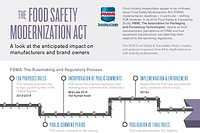Federal laws, third-party food safety certifying agencies, and customer regulations all play key roles in what knowledge you have today regarding food contact packaging rules. Let’s start with some facts and unravel some common misconceptions. Table 1 provides an overview of commonly used materials for food contact packaging and some key information about each.

Fact or Fiction? FSMA applies to food packaging manufacturers
Fiction: Food Safety Modernization act (FSMA) rules do not apply to the manufacturers of food contact materials (bottles, food service containers, cans, etc.).
While packaging does not fall under the umbrella of FSMA, it does fall under a different set of U.S. Food and Drug Administration (FDA) regulations located in Title 21 of the Code of Federal Regulations (C.F.R.) in parts 174–179 and 186. This is where the regulations for indirect food additives, including food contact packaging, are found. The category of indirect food additives also includes adhesives and components of coatings, paper and paperboard components, polymers, adjuvants, production aids, sanitizers, and irradiation processes.
What are food contact packaging manufacturers required to do per federal law? First, comply with Good Manufacturing Practices (GMPs), although, not the GMPs with which food manufacturers are familiar. GMPs are summed up in the following sentences about food contact packaging materials: Ingredients must be suitable for their intended purpose and chemicals within packaging/from the process cannot exceed levels defined as safe by FDA (these levels are specified in the above referenced sections of the C.F.R. for various materials).
At a minimum, food packaging manufacturers must comply with the federal regulations outlined above. Building on the basic premise posed in the law, third-party agencies—both Global Food Safety Initiative (GFSI)-benchmarked and not—came up with their own standards of rules and best practices that food contact materials must comply with to attain and maintain their certification. The commonly used GFSI schemes all have a food packaging standard to which companies can become certified to provide more of a facility-focused inspection and certificate of compliance. Third-party food safety audits are technically optional, but it may be required of a packaging company to have some type of certification per customer requirements. This may be obtained either via a third-party audit or customers may prefer to directly audit their suppliers themselves and issue their own standards for compliance. The variation here boils down to who is buying the packaging materials and what is required.
Today, there isn’t much meat in the regulations for food contact packaging manufacturers in terms of the basic food GMPs and Hazard Analysis and Critical Control Points principles that are second nature to food manufacturers. Striving for increased food safety and the security of the U.S. supply chain is a trend that isn’t going to waver in the years ahead. To get ahead of regulations, training everyone, from front-line workers to management, on basic food safety principles at food contact packaging companies is highly recommended, as packaging is key to consumer safety and the maintenance of a high quality, consistent product.
Kate Malvetti is a food safety subject matter expert, a self-professed food nerd, and former food safety quality audit systems manager in the food & beverage industry with the New Jersey Manufacturing Extension Program.
Wrapping Food Packaging Law into Bite-Size Pieces




